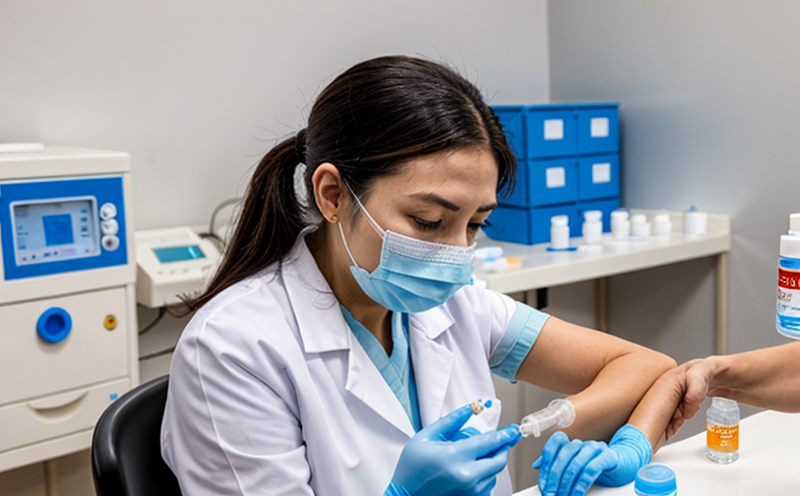EP Identity Testing of Vaccines by ELISA
The European Pharmacopoeia (EP) identity testing is a critical step in ensuring that vaccines are pure, potent, and safe. This process involves the use of Enzyme-Linked Immunosorbent Assay (ELISA), a widely used analytical technique for detecting specific antibodies or antigens.
ELISA tests operate on the principle of using immobilized antibodies to capture target antigens in the sample. The captured antigen is then detected by an enzyme-labeled antibody, which reacts with a substrate to produce a colored product that can be measured spectrophotometrically. This method ensures high specificity and sensitivity, making it ideal for vaccine identity testing.
The process begins with the preparation of the vaccine sample in accordance with standard operating procedures (SOPs). The sample is then incubated with coated plates containing immobilized antibodies specific to the target antigen. Following washing steps to remove non-specifically bound materials, enzyme-labeled secondary antibodies are added. Finally, a chromogenic substrate is introduced, and the absorbance at 450 nm is measured.
The results of ELISA tests provide quantitative data on the presence and concentration of antigens in the vaccine sample. This information is crucial for confirming that the vaccine meets the stringent identity testing requirements outlined in the European Pharmacopoeia. Compliance with these standards ensures product quality, safety, and efficacy.
Compliance officers and R&D engineers responsible for ensuring regulatory compliance will find ELISA-based identity tests indispensable tools in their arsenal. These tests not only aid in meeting regulatory requirements but also enhance the overall reliability of vaccine production processes. By adhering to these stringent testing protocols, pharmaceutical companies can confidently produce vaccines that meet international standards.
Scope and Methodology
| Test Parameter | Description |
|---|---|
| Vaccine Sample Preparation | Sample preparation involves dilution and pre-treatment to ensure consistency with the test protocol. |
| ELISA Plate Coating | Antibodies specific to the target antigen are immobilized on a microtiter plate. |
| Incubation and Washing | The vaccine sample is incubated with the coated plate, followed by multiple washing steps to remove non-specific binding. |
| Enzyme-Linked Antibody Addition | Enzyme-labeled secondary antibodies are added to detect bound antigens. |
| Substrate Reaction and Measurement | A chromogenic substrate is introduced, and the absorbance at 450 nm is measured. |
- Laboratory Equipment: ELISA plates, incubator, washer, spectrophotometer
- Safety Precautions: Use of personal protective equipment (PPE), handling of hazardous materials.
Industry Applications
| Vaccine Type | Testing Requirement |
|---|---|
| Influenza Vaccines | Confirmation of the presence and concentration of hemagglutinin (HA) antigens. |
| Pneumococcal Vaccines | Determination of capsular polysaccharide content. |
| Rotavirus Vaccines | Measurement of rotavirus-specific antigens. |
- Pharmaceutical Quality Control: Ensures the consistency and purity of vaccine batches.
- R&D Validation: Used to validate new formulations and ensure they meet identity testing criteria.
Quality and Reliability Assurance
| Criteria | Description |
|---|---|
| Sensitivity | The test must accurately detect even trace amounts of target antigens. |
| Specificity | No cross-reactivity with other unrelated antigens. |
| Precision | Repeatable results within a narrow range of variation. |
- International Standards Compliance: Testing must adhere to the requirements specified in the European Pharmacopoeia (EP).
- Data Verification: Rigorous internal and external audits ensure data integrity.





